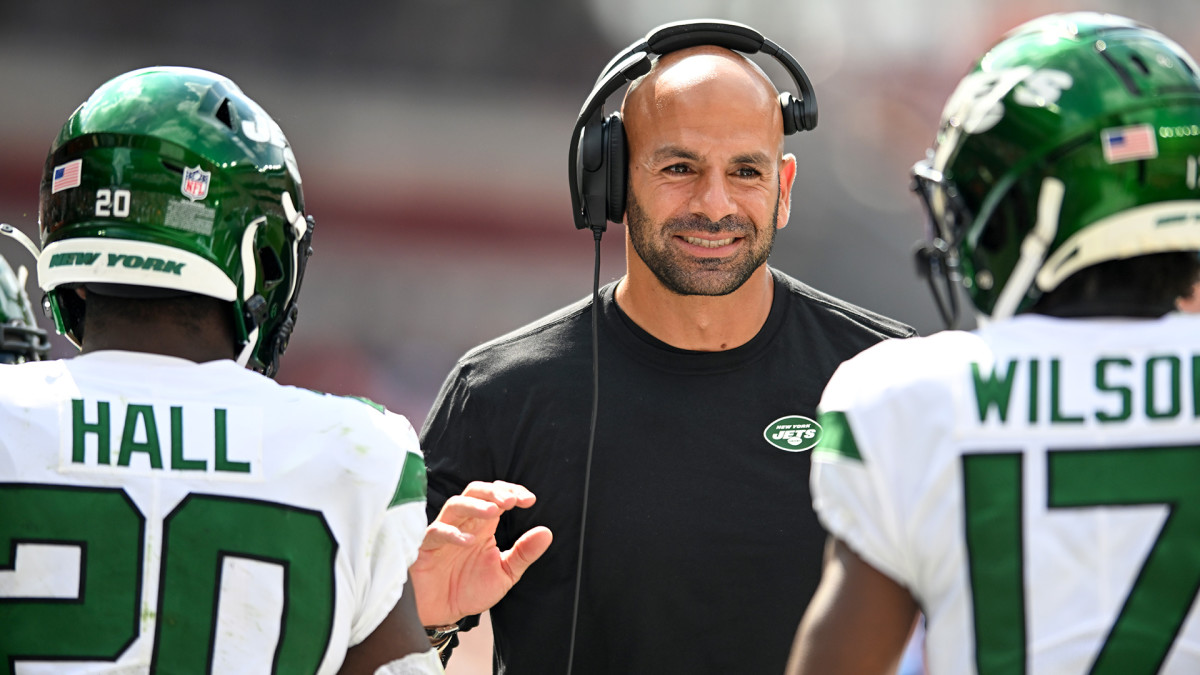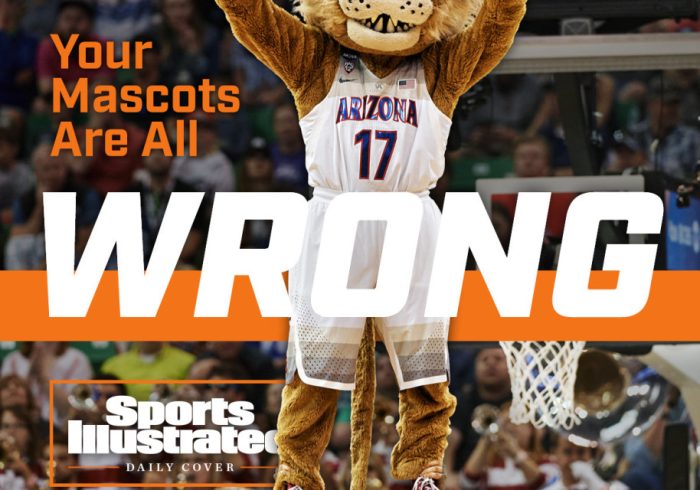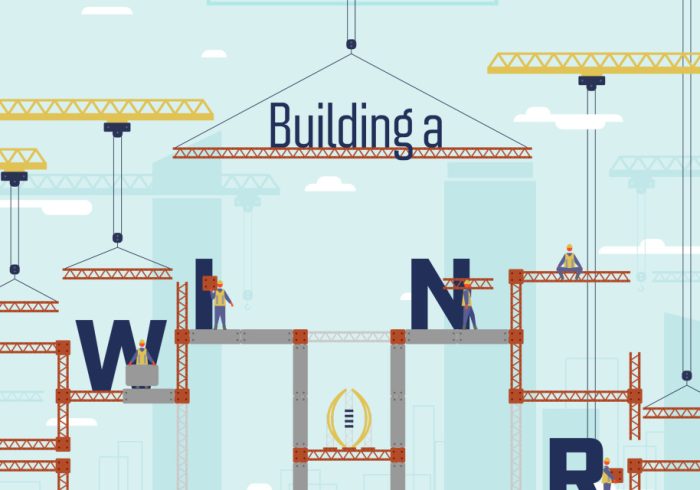Sitting in his office on a Wednesday afternoon, Robert Saleh spills out of a conventional computer chair, long limbs hanging over the armrests, like a parent sitting at a kid’s desk during back-to-school night. Or, perhaps, like a former collegiate tight end crammed into his seat at the back of the plane. That’s where Saleh was on the way home from his team’s stunning 31–30 win over the Browns last week. Taking after former boss and mentor Pete Carroll, Saleh and the coaching staff gave up their first-class seats to players, flying coach back to New Jersey.
In his idealistic crusade to—as he puts it—“leave the Jets better than I found them, whether it’s one year, two years, three years or 15 years,” the job demands an unending attention span and attuned kindness to concerns both large and small. He puts care into a developing wall of photographs that start from the locker room and stretch through the main atrium of the facility, with each panel depicting a portion of the team’s season. The photographs themselves are a small thing. The idea—that the Jets, a team historically consumed by a narrative of negativity and organizational face-planting that seemed to envelop every player and coach who walked in the door for a decade, are actually in control of telling their own story—is a large thing. So is understanding the need to point it out.
Keeping an adjustable basketball hoop in the team’s main meeting room where he sometimes makes coordinators shoot high-pressure free throws to break ties from practice in front of the whole team to make them laugh and keep them competitive? That’s a small thing. Holding firm on an actual open-door policy where he sees every issue brought to his desk as “deserving of the respect of my attention” keeping his hands firmly on the wheel of the NFL’s most sprawling roster rebuild without bailing? That’s a large thing.
“One thing I learned last year is that it’s curveball after curveball after curveball,” Saleh says. “People coming in and out of the office. Which is fine. I want them to do that. I don’t want any secrets or snakes popping out of the grass. I don’t want to say, ‘Why didn’t anyone tell me this was going on?’ Don’t protect me from things. Let me know so I can handle it. There’s a balance, but there are some trying days like, Are we really talking about this right now?
“But if someone walks into my office to address something with me, then it’s very important to them.”
The 1–1 Jets are hosting last year’s conference champion Bengals on Sunday and have a chance to earn a winning record for the first time since Sept. 10, 2018, when the club won its season opener against the Lions and proceeded to lose seven of its next nine games. They do so with more positive vibes reverberating inside the walls of 1 Jets Drive than in almost a decade. The franchise has not finished with a winning record since ’15 and has not made the playoffs since ’10. But in a unique time around the NFL, when new head coaches and GMs are arriving at their jobs and immediately liquidating their draft equity and free-agency capital for the prospect of an immediate winner, Saleh, general manager Joe Douglas and the Jets remain committed to a total makeover.
It is, all at once, romantic, ideological, maddening and completely necessary given how deep the talent void was when the pair arrived. And as he balances the patience of unearthing progress with the talent of a group Saleh says “just feels different,” he does so like a tightrope walker ambling from building to building thousands of feet in the air. There is no opportunity to look down, only small steps between where the Jets have perpetually been, and a place of sustainable roster health and success, which has been found only in small plumes here since the turn of the millennium.
“You can get it like they did in 2015, but it’s not going to last,” Saleh says, referencing the team’s 10–6 season with Ryan Fitzpatrick at quarterback, during which they finished a game out of the postseason. “You’re getting into salary cap hell and you’re just chasing all the time. We want to build a roster that can weather the storm. Be consistently good. Schemes that are consistent, where everyone can evolve with one another.
“Obviously, you have to show you’re progressing. A lot of the time, people look at the end result, which is deserved. But if you are really looking at the team, at the Jets today as compared to the last five years or whatever, you’d have to be blind not to say this group is going. It’s just a matter of piecing it together now and winning football games.”
Let’s get one absolute truth out of the way: Patience and pragmatism are historically two of the most abused words in the NFL. For some coaches and GMs, the idea that they have this grand plan that requires time and resources to execute is a red herring covering up a fatal flaw. A collective eye roll is entirely understandable when a fan base that hasn’t celebrated a Super Bowl since a few months after the original Woodstock is asked to hang on a little longer.
Parsing out the difference between a rebuild of necessity and a rebuild to nowhere can also be difficult. In NFL circles, information comes from the GMs and coaches who want you to believe they need more time, or opposing GMs and coaches who would like that job and—obviously—think they could do it faster. It creates an Alaskan blizzard frontier by which we view almost every situation—clear as cement. Only a few years removed can we start to peel back the layers and understand who was right.
The Jets, however, cannot be the Buccaneers or the Rams, sitting one quick-fix QB away from a Super Bowl. At some point, they had to accept it.
There is a popular psychological stress and pain reduction tool called “mindfulness” in which the patient is asked not to avoid something that is painful or stressful or aggravating, but to simply sit with it. To give it a shape and a feel. To understand all of its forms. After years of escapism, it seems the Jets have nobly tried to sit with their past and to feel the ramifications. Start over, but really start over. In 2021, a season of four wins and 18 slots filled on injured reserve, they had their moment of mindfulness.
While he has never commented on the performance of a prior regime and hasn’t used it as an excuse, the Jets’ roster building for almost a decade before Saleh arrived was, objectively, terrible. During that stretch of time, 2013–19, the franchise managed to draft just three players—Sheldon Richardson, Leonard Williams and Jamal Adams—who reached a Pro Bowl. Two GMs—first John Idzik, then Mike Maccagnan—swung and missed on young quarterbacks. They were never good enough to legitimize signing any of the stalwart players to long-term contracts, because the rest of the roster was in tatters. The large contracts that were handed out, were given to the likes of Trumaine Johnson, Muhammad Wilkerson and Le’Veon Bell. The GMs were also not always tied ideologically to the coaches, meaning that spirits of misalignment cost them chances at quality talent.
Dee Milliner, Calvin Pryor and Darron Lee could have all been fine players but seemed to arrive as mismatched pieces for another puzzle. Nothing resembling a solid platform from which to start was carried over from one group of decision-makers to the next.
It created a kind of irregular heartbeat for the franchise. Restart, panic after Year 2 (or 1), throw money at the problem and watch the whole thing collapse. Good players get frustrated and leave, which contributes to the narrative Saleh has tried to exterminate. One cycle of this can be devastating. Multiple cycles can erase a franchise for years.
It is O.K. for the Buccaneers to sign Tom Brady when they already had Mike Evans, Ali Marpet, Chris Godwin, Lavonte David, Ryan Jensen, Donovan Smith, Vita Vea, Jason Pierre-Paul and so on. It is O.K. for the Rams to invest in the moment when they already had Aaron Donald, a then potent Todd Gurley and hit the jackpot on Andrew Whitworth, who, despite being 35, had five more years of Pro Bowl–level football left.
It was O.K., even, for Rex Ryan to do it back when he took over as the Jets’ head coach in 2009. Though the turnaround under Ryan seemed stark and dramatic, already on the roster were D’Brickashaw Ferguson, Nick Mangold, Tony Richardson and rookie Darrelle Revis. Three of those players are in the franchise’s ring of honor (and Richardson is in the Chiefs’). They also had Alan Faneca, a player who would soon be in the Pro Football Hall of Fame, and Shaun Ellis, one of the best pass rushers in franchise history.
Ryan was a tremendous orator who was able to—at times—successfully back up the idea that the Jets were not the punch line everyone had decided they were. This was obviously made easier when a still-talented LaDainian Tomlinson, another player headed for the Hall of Fame, was there to help legitimize it.
When Saleh took over as head coach of the Jets, his best players were, arguably, Jamison Crowder and C.J. Mosley. Everything was going to get homegrown.
It would seem to be a difficult position for a coach to walk into. Here is a franchise that has not provided a blip of excitement in six years. Without saying as much, you now have to explain that the previous half decade or more was simply the line to get into the line.
“I get all the sins of the past years, but this is a new group,” Saleh says. “You’ve got to give them a chance to find their footing and make their mark.”
The difficult part about real progress in a situation like this is that it’s largely obscured from the three-hour performance the team puts on every Sunday. And in that haze, outside observers have to decide whether this is just another irregular heartbeat, or if this is the precursor to longevity as a relevant, fun-to-watch franchise.
When asked about what he sees that we don’t see, Saleh relayed a conversation he had with linebacker Kwon Alexander, one of the free agents the team signed this offseason. Alexander played for Saleh back when the coach was a defensive coordinator for the 49ers.
“The first couple of days of practice he said, ‘Man, coach, the group is too quiet,’” Saleh says. “I said, ‘They’ll come around; they just need a little confidence.’”
In the following weeks, he said, the volume started to increase. Verbal communication. Celebration. All organically.
“There’s a level of juice you feel from the team, from having conversations, from watching tape, the way they go out together. There’s just a really cool bond with this team,” he says.
Another example?
“From a cultural standpoint, one thing that’s been—to me, from an outsider looking in, and I don’t want to jinx it, but—I don’t feel like we do things that shoot ourselves in the foot with off-the-field stuff,” he says. “I feel like between [GM Joe Douglas] and myself, we’re doing a lot of the right things, making the right decisions for the organization as a football staff. The players are making the right decisions. They’re doing the right stuff; they’re in the community. They’re doing things that great organizations and great people do.
“From that regard, you can’t possibly be on the outside looking in and be a fan of the past looking at this place and saying ‘they’re still slappies.’”
Saleh feels the best franchises eventually run themselves. But this process takes time. There is setting expectations, then solidifying those expectations. He joked that when a player puts his best on film and then turns in an effort below standard, the line is “You f—ed up, buddy,” meaning that the player already showed what he is capable of. At some point, the best moments are replicated consistently. Everyone knows the standard.
Sometimes this is an enjoyable process, and sometimes, like after the Jets beat the Browns in Cleveland, that meant juxtaposing one of the signature wins of Saleh’s tenure against the expectations they had for themselves. The Browns scored a touchdown to go up 31–17 with 1:55 left in the fourth quarter at a time when the Jets had no timeouts. If Browns running back Nick Chubb had simply fallen down before the goal line or stepped out of bounds rather than run into the end zone (Chubb acknowledged his mistake Tuesday), Cleveland would have been able to kneel the clock out.
“The game should have been 24–17 [a Browns win],” Saleh says. “[Chubb] takes a knee. It’s over. We’re talking about how we let it slip in the fourth quarter. It’s awesome, but you have to be real with yourself, and tell yourself the truth about what happened.”
Saleh is trying to make his truth the Jets’ truth now. Hence, the wall of photos. A self-reflection. In their loss to Baltimore in Week 1, maybe there were portions of that game that featured better play than in a victory over Cleveland in Week 2. This is a way to remind them that, for now, all that matters is what they believe.
For a franchise that surrendered its ability to control what it means to be The Jets years ago, the hope is that these little realizations will add up into something more sustainable; more believable to them, to Saleh, to us, to you.
More NFL Coverage:
• Which Winless Teams Can Still Save Their Season?
• Mailbag: Finding a Mac Jones Comp
• Mike McCarthy Proves Himself . . . for Now



